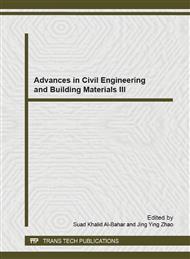[1]
Okamura H., Ouchi M Self-Compacting Concrete, Journal of Advanced Concrete Technology, Vol. 1, No. 1. PP 5-15, (2003).
Google Scholar
[2]
Jagadesh Vengala M.S., Sudarshan and , Ranganath .R. V Experimental study for obtaining self compacting concrete, The Indian Concrete Journal, Vol. 77, No. 8, p.1261 – 1266, (2003).
Google Scholar
[3]
Prashant Bhuva, Evaluation of Properties of Fresh Self Compacting Concrete, Second National Conference on Emerging Vistas of Technology in 21st Century, pp.27-36, (2010).
Google Scholar
[4]
Naveen Kumar C , Kiran V. John , Jagadesh Vengala & Ranganth R. V , Self-Compacting Concrete with fly ash and metakaolin", The Indian Concrete Journal, pp.33-39, (2006).
Google Scholar
[5]
Jagadesh Vengala & Ranganath .R.V. Effect of Fly Ash on Long term Strength in High Strength Self Compacting Concrete,. INCONTEST, 10-12, pp.341-347, (2003).
Google Scholar
[6]
Ouchi M., Hibino M., Sugamata T. and Okamura H. A quantitative evaluation method for the effect of superplasticizer in self compacting concrete" Transaction of JCI, pp.15-20, (2001).
Google Scholar
[7]
Okamura H., Ozawa K., Mix Design for Self-Compacting Concrete, Concrete Library of Japanese Society of Civil Engineers, pp.107-120, (1995).
Google Scholar
[8]
Subramanian, S. and D. Chattopadhyay, Experiments for mix proportioning of self-compacting concrete, The Indian Concrete Journal, pp.13-20, (2002).
Google Scholar
[9]
Su N., Hsu K C., and Chai H W., A simple mix design method for self compacting concrete, Cement and Concrete Research, Vol. 31, pp.1799-1807, (2001).
DOI: 10.1016/s0008-8846(01)00566-x
Google Scholar
[10]
The European guidelines for self compacting concrete, (BIBM, CEMBUREAU, EFCA, EFNARC, ERMCO) www. efnarc. org, 2005.
Google Scholar
[11]
Kamal, M., Gailan, A. H., Haatan, A. , Hameed, H., Aggregate made from Industrial unprocessed Slag, Proceeding of the 6th International Conference on Concrete Technology for Developing Countries, Amman, Jordan, (2002).
Google Scholar
[12]
Ouchi M. AND Edamatsuy A simple evaluation method for interaction between coarse aggregate and mortar particles in self compacting concrete, Transaction of JCI, pp.50-18, (2002).
Google Scholar
[13]
Dr.P. Srinivasa Rao, Seshadri Sekhar. T Compressive, Split tensile strength, Flexural strength of self compacted concrete, . Journal of Future Engineering & Technology, Vol 3, pp.78-82, (2007).
DOI: 10.26634/jfet.3.1.706
Google Scholar


